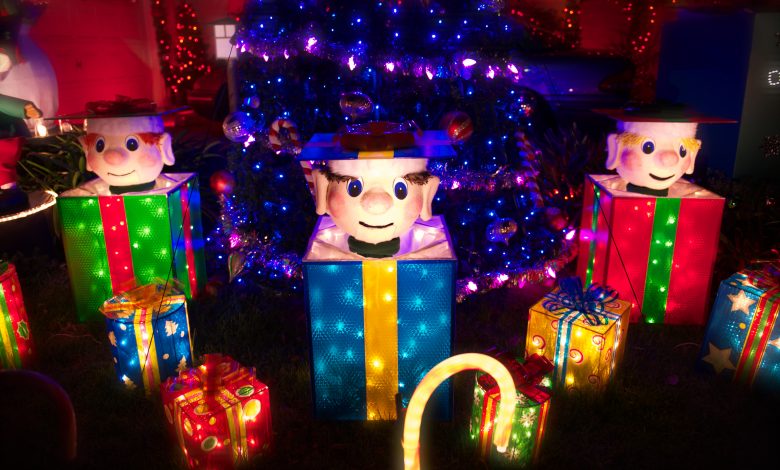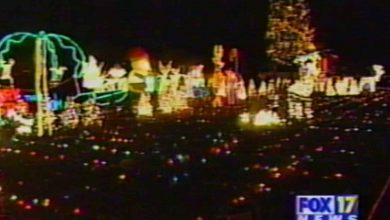Animatronic Figures
Real movement wows the audience


It was many years ago, but I can still remember our yearly Christmas journey from Northwest Indiana to downtown Chicago. Our plan was to visit the windows at the Marshall Fields department store; it was a yearly highlight! I was excited to see what amazing things were waiting for us at the ultimate Christmas destination! Inside and out, the store was a child’s fantasy of sights and sounds. Each window was part of a scene in a contiguous story. Elaborate animated characters performed on their own individual stages. There was so much to look at, so much to take in, as we huddled in the cold, peering into each window. I studied each scene, hoping I could bring a small portion of it back to my small town of Saint John, Indiana into my display.
Before there was a “Lights on Display,” there was a family display tradition started by my father when I was just a few years old. Hanging lights was never his thing. His displays consisted of motorized plywood figures or other props fashioned from parts found around the house. I can still remember some of his handiwork. One year, a full-size Santa Claus, fashioned from an old time Santa costume, sat at a large pipe organ and played Christmas tunes. Santa’s arms moved up and down, connected by fishing line to a cam on a gear motor attached up above. As the cam rotated, Santa tapped out a tune. Back then, there was no such thing as a CD or mp3 file. A record spun on a turntable, starting over and over again each night for accompaniment. For another year, my father built a large shed which became Santa’s Workshop. Numerous animated elves hammered, painted and sewed toys in the shop. Standard plywood cutout patterns were modified to have the appropriate motion that matched their design. It was very simple by today’s standards, but back then, it was truly magical!
As the years went by, I took over my father’s display duties. It
was time to carry on the tradition! Some of my first displays weren’t very memorable. I’m sure they looked incredible to me at the time, but I had limited abilities, and I still had a lot to learn. I had very few lights, and I scrounged together a few random blow molds and a few cutouts I created. Back then, you either plugged in the lights each night, or a simple mechanical timer was standing by to turn on the display for the evening. As I think back, it’s amazing what my parents let me get away with. My father created a large wooden waterwheel which was attached to the front of the house. One year I had the bright idea to turn it into a ferris wheel, complete with little elves, silver garland, and lights on the spokes. A ferris wheel needs to rotate, so a gear motor was attached to turn the wheel. But how to keep the lights illuminated? This called for a homemade slip ring to transfer the power along the shaft and onto the wheel. What resulted wasn’t pretty, but it worked! –except for the lines of static interference on the family TV! And, oh, upon touch, a slight tingle from the metallic garland. Thankfully I lived and learned and can write about it today!

It’s been a long time, so I don’t remember what my first full-size animated figure was, but I was very proud of an 8’ nutcracker created out of chicken wire, fabric and plywood. It was based on a small nutcracker that I collected as a child. The body turned side to side, powered by a small vending machine gear motor. I think back on how difficult it was to find the necessary parts needed for these builds; doing a “Google” search hadn’t been invented yet! Many of these figures were high maintenance and required many repairs throughout the holidays. There was no computer control back then, at least not for the home market, so I was limited to basic motion (much like the windows I admired as a child). I was on my way to achieving the home display I dreamed about! A new animated figure was added each year until I moved to Los Angeles in 1999 to pursue a job in the entertainment industry. Knowing that I wouldn’t have the room to store or display everything out in L.A., I sadly gave away my whole collection to my relatives. It was the first and only year without a display, and a time start over!
My first LA displays were as simple as they come; more time was spent fixing up the house and producing an independent film project with friends. In the fall of 2003, I remember sitting in my edit bay during a work break, searching the net for computer controlled lighting systems. I stumbled across the Animated Lighting site, I put my order in, and I was ready to take my display into the computer controlled era! The first few years were again very simple, I started small, but by 2005, I went full steam ahead! I was very happy with the lights, but I really wanted a complete show with performers and a host.

DJ Jingles made his first appearance in 2006 –the year I introduced synchronized video to my display. I was closer to achieving the “show” aspect I wanted, but what I really wanted was to have the full size animated characters I once had in my display. However, this time, I wanted to control them with my computer. I started sketching up a few ideas. I wanted to create a versatile performer that could sing along with most any song and would be useable year after year. In 2008, Frosty the animatronic snowman was born. He was an immediate hit with my visitors, and his performance took my show to a whole new level! I wasn’t able to control my animatronic using Animation Director, but I used one of my lighting channels to trigger a standalone control board called the Wizard 3, from Blue Point Engineering. Animation was achieved fairly simply by turning a small potentiometer and animating each movement individually.
Although it was simple to animate, one mess-up at any point in the routine while programming resulted in my having to reprogram the entire ten minute show. (I would have to start over for that servo.) It was a tedious process, but I had good results with the controller. The following year I decided some dancers were needed to tap out the tunes, so I built two tap dancing elves. Their movements were powered by two car door actuators that raise their feet and move their torsos side to side. Now I had the talent, but I needed a physical host; so in 2010 I built an animatronic DJ Jingles. He was an instant hit! His lift mechanism was probably one of the most difficult things I had built up to that point. I needed an actuator that was fast and strong enough to lift him and his DJ gear. It took quite a few redesigns to get it just right, but he was then ready to raise up from his box and spin the hits each night.

I thought I’d take it easy in 2011 and just build a Santa, sleigh and reindeer to replace the inflatable I had on my roof, but it ended up becoming one of the most labor intensive, time consuming projects of all! The sleigh was built out of a steel and aluminum under structure, clad in a coated and carved Styrofoam. There was so much carved Styrofoam on tarps in my driveway, I feared a random microburst would come along and cause a freak snow storm in the San Fernando Valley! I wrapped up the project just in time, but I wasn’t able to animate Santa or Rudolph like I wanted. That would have to wait until next year. I also made the switch over to Light-O-Rama for my display. I was finally able to partially integrate servo control using the Servo Dog controllers. It was nearly impossible to get smooth organic movements using the sequence editor, so I still used the channel triggered Wizard 3 controller to control the heads, and the sequence editor to control mouths, guitar and arm movements.

My 2012 show was a display built on many years of work, plus a few new additions. I needed some backup singers, so I built my singing pop-up elves. They were another big project, which took most of the Summer to complete. Each package contains a servo for the mouth and an actuator to pop the head out of the package. I was also able to animate the sleigh with a large actuator lifting it off its platform each night. Animation was added to Santa’s arm and Rudolph’s leg as well. Last year, there was a total of 16 servos and 9 actuators; it was a lot to keep organized! I discovered a program called TrackSkull by MonkeyBasic. The software allowed me to achieve smooth, organic “life-like” movements with Jingles and Frosty’s head motion. This meant that I could integrate full show control into the Light-O-Rama Sequence Editor.
For the past few years I’ve received numerous “how-to” requests for my animatronic projects as well as requests to purchase some of my characters. So this year, I decided to take the leap and start “Season’s Greeters,” a new company designed to create affordable and fully programmable animatronics for home and commercial displays. An affordable, user-programmable animatronic is very unique. It’s something that’s only been available in the theme park market. With the pairing of TrackSkull and an infrared tracking camera, it’s now quite easy to achieve professional results without days or weeks of programming. The camera captures the operator’s head movements, while the animatronic mirrors the position and speed. It’s true puppeteering, and it’s actually fun! The routine can be saved and then exported directly to the Light-O-Rama Sequence Editor.
Months of time and work went into redesigning my snowman to create a robust and professional product. Frosty is the first of a planned line of user programmable animatronics which can be integrated into one’s display. I’ve hired some very talented people to contribute to the production of Frosty, and I’m proud to say he’s “made in the USA.” We will offer pre-programmed routines packaged with the animatronics for those interested in a plug-n-play product.
I truly enjoy sitting in the garage tinkering on each new project. It’s a great feeling to take a bunch of raw materials and turn them into something that many will truly enjoy!
This article was included in the September 2013 issue of PlanetChristmas Magazine.
By Mike Ziemkowski




